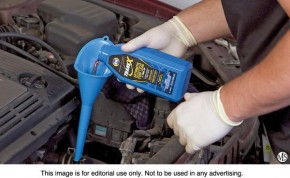How to fix leaky vehicles without breaking the bank
(MS) — Drivers expect to experience a few bumps in the road as their vehicles age. While certain issues, such as worn shocks or engine troubles, are best left to the professionals, drivers can address many other issues that commonly affect aging vehicles on their own.Fluid leaks are one of the more routine problems that plague older vehicles. While leaks are not necessarily a sign of doom and gloom, they tend to distress vehicle owners and can affect drivability. In addition, automotive fluids that seep out of vehicles can prove harmful to the environment.
Leaks may not be a concern for drivers of new vehicles, but studies show that drivers are keeping their vehicles for longer than ever before, suggesting that leaks are becoming a greater issue for more and more motorists. A 2016 study from the Institute for Highway Safety found that the average age of vehicles on the road in the United States is nearly 12 years. By 2021, the IHS expects a 30 percent increase in vehicles that are 16 years or older.
So how can drivers address leaky vehicles before they contribute to potentially larger, more costly problems? Fortunately, leaks can be a relatively simple fix, which should assuage any fears drivers may have as the numbers on their odometers continue to rise.
Identifying leaks
Identifying leaks is the first step toward fixing them. According to CRC Industries, a global leader in specialty maintenance and repair chemicals, including K&W brand Stop Leak products, the simplest way to identify which fluid is leaking is to determine its color. CRC notes that red fluid suggests a leak in the power steering system or transmission, while black fluid typically indicates old oil or transmission fluid that has gone bad. If the leaky fluid is green or yellow, then it’s likely engine coolant.
Fixing leaks
Once drivers have identified which fluid is leaking, they can then take steps to fix the leak. Unlike other problems that plague older vehicles, leaks can typically be fixed quickly and affordably.
“Stop leak products can really save the day, especially if the leak means that you have to stop driving the vehicle,” says CRC Technical Service Manager Scott Brownstein. “Our K&W Stop Leak solutions are designed to provide faster, less expensive alternatives for drivers who may be facing costly mechanical repairs.”
Stop leak products can be especially valuable to drivers of older vehicles, who may not want to pay for repairs that could very well exceed the value of their cars and trucks. In addition, replacement parts for older vehicles are oftentimes not readily available. In such instances, stop leak products can help drivers keep their cars on the road until replacement parts are found. Stop leak products also can be valuable in the face of emergencies, giving drivers time to get their vehicles to their mechanics.
K&W Stop Leak products are available to address any type of leak drivers may encounter, and drivers need not be car savvy or mechanically inclined to use the products without professional assistance. For example, K&W’s Super TurboTM Engine Oil Stop Leak and Steer-XTM Power Steering Stop Leak employ a “Pour & Go” formula that can get drivers and their vehicles back on the road in 10 minutes.
As more and more drivers look to extend the life of their vehicles, leaks figure to factor more heavily in the lives of motorists. Addressing such leaks can be easy, quick and affordable. Learn more about fixing leaks at www.stopautoleaks.com/metro. SC183861


